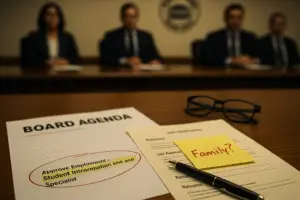Update/Clarification published 9/3/2025: https://eastof52.com/the-tone-zone-where-adjectives-get-a-23-point-traffic-stop/
“We had peace and balance again — and they took it from us,” says April, a parent who’s had children at Dehesa School for over a decade. She’s referring to the abrupt dismissal of a well-loved principal, the quiet disappearance of multiple long-serving teachers, and the unexplained collapse of morale across a once-thriving rural school district. Her anger isn’t just emotional. It’s backed by a paper trail five years long and millions of dollars deep.
This is the story of how Dehesa School District — a tiny, one-school district east of El Cajon —overstated attendance-based revenue claims according to its own audit, lost its way, and now faces material fiscal risk if the questioned ADA is upheld—risk that could prompt heightened county oversight. It’s also a story of what happens when a district’s leadership forgets who it’s supposed to serve.
The Charter Boom: Illusion of Prosperity
In 2018, Dehesa appeared flush with cash. The district had authorized nine charter schools enrolling over 11,000 students — even though the local district only served about 130. These charters weren’t in Dehesa; they were scattered across the state. But the district collected millions in oversight fees and other revenues linked to those students, creating the illusion of a booming, well-funded system.
Auditors later flagged major issues: Dehesa overcharged fees, failed to keep proper Memoranda of Understanding (MOUs) with several charters, and had weak internal controls. The state ultimately cracked down. Several of the charters were linked to the infamous A3 charter fraud scandal that swept through California’s education system. The golden era ended.
2019: The Fall Begins
By 2019, oversight fees were legally capped at 1%, and the easy money dried up. But Dehesa didn’t downsize. It didn’t restructure. It kept spending like a district three times its actual size.
The budget still hovered around $3.5 million a year, even as student attendance dropped below 100. Reserves began to shrink. The district ran a deficit four years in a row, dipping into savings it had once boasted as a point of pride.
Today, the district’s reserves are down more than 60% since their peak. And unless drastic cuts are made or new revenue appears, Dehesa will likely trigger county or state fiscal oversight within the next two years.
No Checks, No Balances
Financial mismanagement is only one piece of the puzzle. At the governance level, Dehesa has what appears to be a deeply broken structure.
Five board members currently govern the district. According to parents, three are from one family: a husband, wife, and son, and two from another family; The other two are also a married couple.
Although Richard and Cinthia White filed for divorce in 2021, the case was quietly dismissed in October 2023—just weeks before Richard resumed his position on the Dehesa School Board. During the case, one of them filed a change of address, raising questions about whether they were still cohabiting—and, more importantly, whether both board members still resided within district boundaries as required by law.
But even more troubling than the paperwork is the power dynamic. The Dehesa School Board is made up of three members of the White family and two members of the Pham family. That means all five board seats—and all taxpayer funded compensation tied to them—are controlled by just two families. In a district that has faced financial collapse and leadership scandals, this isn’t just questionable. It’s a governance crisis.
This isn’t about one bad vote or one overpaid administrator. This is about an entire public school system held together by a fragile arrangement of family loyalty, closed-door decisions, and concentrated financial control. And when that’s the foundation, it doesn’t take much to make the whole house of cards come down.
Grievances from parents and staff — about everything from intimidation to staffing concerns — are routed to Superintendent Bradley Johnson. But Johnson also holds the role of Chief Business Officer, effectively making him the only point of accountability in the district.
And Johnson wasn’t even qualified for the job when he was hired. Records show he required a state waiver to serve as superintendent, a rare move typically reserved for emergencies or when no credentialed candidates are available. Yet the board moved ahead, granting him not only leadership over the district but control of its finances as well.
Culture of Silence and Fear
The financial collapse might be quiet on paper, but it’s been deafening on campus. Parents report the forced resignation or removal of beloved staff. A principal who brought peace back to the school was let go without explanation. Staff morale is at an all-time low. One long-serving teacher “retired”… only to be spotted teaching in another school district shortly after. Unless they were angling for a Tom Brady-style unretirement tour, it sure looks like a forced exit dressed up for HR.
April, the parent who contacted East of 52, says she and other parents have been ignored, silenced, or spoken down to in board meetings. Formal grievances have gone nowhere. Her group now has a list of parents ready to speak on the record, despite the fear of retaliation.
The Numbers Don’t Lie — But They Do Warn
There is no evidence of current criminal wrongdoing in the 2020–2022 audits. No embezzlement. No off-book accounting. But that doesn’t mean the district is healthy. The real red flag is structural:
ADA has dropped to around 75. LCFF funding is drying up.
Expenditures still hover above $3.5M/year.
The reserve fund is projected to hit minimum levels soon.
A $1.2M general obligation bond was issued in 2022, adding debt pressure.
Administrative expenses totaled $545,415 in 2022 — 14% of all spending — abnormally high for a one-school district.
$68,500, carried forward. No clear, public-facing explanation. Parents asked in open meetings and, by their account, hit a wall. The ‘why’ finally surfaced only after a weekend document dig. Public access shouldn’t require archaeology.
Interest income was only $22,654 on $5.6M in cash, suggesting poor treasury management.
Audit Access and Transparency Breakdown
As of July 15, 2025 (publication date), the 2024 audit was not posted on the district’s Audits page; available copies were buried in board-agenda packets.
Additionally, while board packets exist, Dehesa does not maintain a dedicated, readily accessible online archive of approved minutes and vote outcomes; instead, they’re embedded inside agenda PDFs—leaving the public to sift through documents to verify decisions.
So while audits or minutes may have been posted somewhere, that is not the same as transparent, easy public access without a scavenger hunt.
What Happens Next?
Unless the district realigns spending, restructures leadership, and brings in outside oversight, its fiscal future is bleak. Parents are organizing. Whistleblowers are speaking. And audit data backs up every concern.
The only real question left is: Who will act first — the board, the county, or the community?
Because when the same person drafts the budget, approves the spending, and signs off on the audit, it’s not oversight. It’s a closed loop.
This story is still unfolding.
If you’re a Dehesa School District parent, student, staff member, or community member with insight or documentation, email: [email protected]. Confidentiality respected.
Let’s dig in.




